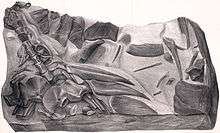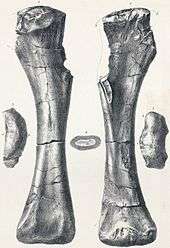Hastings Beds
| Hastings Beds Stratigraphic range: Valanginian, 140–136 Ma | |
|---|---|
| Type | Group |
| Unit of | Wealden Supergroup |
| Sub-units | |
| Underlies | Weald Clay Group |
| Location | |
| Region | Europe |
| Country |
|
The Hastings Beds is a geological unit that includes interbedded clays, silts, siltstones, sands and sandstones in the High Weald of southeast England. These strata make up the component geological formations of the Ashdown Formation, the Wadhurst Clay Formation and the Tunbridge Wells Sand Formation. The term 'Hastings Beds' has been superseded and the component formations are included in the Wealden Group.[1]
The sediments of the Weald, including the Hastings Beds, were deposited during the Early Cretaceous Period, which lasted for approximately 40 million years from 140 to 100 million years ago. The Hastings Beds are of Early Berriasian to Late Valanginian age.[1] The Group takes its name from the fishing town of Hastings in East Sussex.
Dinosaur remains are among the fossils that have been recovered from the included formations.[2]
Vertebrate palaeofauna
Pterosaurs
Color key
|
Notes Uncertain or tentative taxa are in small text; |
| Pterosaurs reported from the Hastings Beds | ||||||
|---|---|---|---|---|---|---|
| Genus | Species | Location | Stratigraphic position | Material | Notes | Images |
|
C. clavirostris[3] |
|
"Anterior portion of rostrum"[3] |
An ornithocheirid pterosaur. |
|||
|
S. sagittirostris |
|
|||||
Ornithischians
Color key
|
Notes Uncertain or tentative taxa are in small text; |
| Ornithischians reported from the Hastings Beds | ||||||
|---|---|---|---|---|---|---|
| Genus | Species | Location | Stratigraphic position | Material | Notes | Images |
|
B. dawsoni[4] |
|
Wadhurst Clay |
"[Two] partial skeletons."[5] |
An iguanodontian |
| |
|
H. armatus[6] |
"Partial skull, skeleton, isolated postcrania."[8] |
|||||
|
H. fittoni[4] |
|
Wadhurst Clay |
An iguanodontian | |||
|
I. anglicus[7] |
|
"Teeth."[10] |
Reclassified as Therosaurus anglicus | |||
|
I. dawsoni[4] |
Reclassified as Barilium dawsoni | |||||
|
I. fittoni[4] |
Reclassified as Hypselospinus fittoni | |||||
|
I. hollingtoniensis[4] |
Junior synonym of I. fittoni.[4] | |||||
|
R. northamptoni[7] |
|
Nomen dubium.[7] | ||||
|
S. major[7] |
Nomen dubium. | |||||
|
T. horneri[11] |
|
"Internal mold of sacrum."[12] |
Dubious genus that has been variously classified as either a saurischian or ornithischian.[13] It is currently only tentatively regarded as dinosaurian.[11] | |||
|
T. anglicus[7] |
|
|||||
|
V. canaliculatus[7] |
|
|||||
Saurischians
Color key
|
Notes Uncertain or tentative taxa are in small text; |
| Saurischians reported from the Hastings Beds | ||||||
|---|---|---|---|---|---|---|
| Genus | Species | Location | Stratigraphic position | Material | Notes | Images |
|
A. dunkeri[4] |
|
"Dorsal vertebrae."[14] |
| |||
|
C. brevis[6] |
|
Synonymous with Pelorosaurus conybeari | ||||
|
H. becklesii[4] |
|
Forelimb |
A ?basal macronarian | |||
|
M. oweni[7] |
|
Reclassified as Valdoraptor oweni.[7] | ||||
|
P. conybeari[7] |
|
"Humerus [and four] caudal vertebrae."[16] |
A basal titanosauriform | |||
|
P. valdensis[6] |
A dubious basal titanosauriform[6] | |||||
|
S. cultridens |
A spinosaurid | |||||
|
T. horneri[11] |
|
Dubious genus that has been variously classified as either a saurischian or ornithischian.[17] It is currently only tentatively regarded as dinosaurian.[11] | ||||
|
V. oweni[7] |
|
"Metatarsals."[18] |
||||
|
W. valdensis[7] |
|
|||||
|
Indeterminate |
|
|||||
|
Unnamed maniraptoran |
Specimen BEXHM: 2008.14.1[19] |
Ashdown formation |
Possibly an oviraptorosaur[19] | |||
See also
Footnotes
- 1 2 Hopson, P.M., Wilkinson, I.P. and Woods, M.A. (2010) A stratigraphical framework for the Lower Cretaceous of England. Research Report RR/08/03. British Geological Survey, Keyworth.
- ↑ Weishampel, David B; et al. (2004). "Dinosaur distribution (Early Cretaceous, Europe)." In: Weishampel, David B.; Dodson, Peter; and Osmólska, Halszka (eds.): The Dinosauria, 2nd, Berkeley: University of California Press. Pp. 556-563. ISBN 0-520-24209-2.
- 1 2 3 Rodrigues, T.; Kellner, A. (2013). "Taxonomic review of the Ornithocheirus complex (Pterosauria) from the Cretaceous of England". ZooKeys. 308: 1–112. doi:10.3897/zookeys.308.5559. PMC 3689139. PMID 23794925.
- 1 2 3 4 5 6 7 8 9 10 11 12 13 14 15 "10.19 East Sussex, England; 1. Hastings Beds" in Weishampel, et al. (2004). Page 559.
- ↑ "Table 19.1," in Weishampel, et al. (2004). Page 416.
- 1 2 3 4 5 6 7 8 "10.19 East Sussex, England; 1. Hastings Beds" and "10.18 West Sussex, England; 1. Hastings Beds" in Weishampel, et al. (2004). Page 559.
- 1 2 3 4 5 6 7 8 9 10 11 12 13 14 15 16 17 18 19 20 21 22 23 24 25 26 27 "10.18 West Sussex, England; 1. Hastings Beds" in Weishampel, et al. (2004). Page 559.
- ↑ "Table 17.1," in Weishampel, et al. (2004). Page 366.
- 1 2 "10.19 East Sussex, England; 1. Hastings Beds" and "10.18 West Sussex, England; 1. Hastings Beds" and "10.21 Kent, England; 1. Hastings Beds"in Weishampel, et al. (2004). Page 559.
- ↑ "Table 19.1," in Weishampel, et al. (2004). Page 415.
- 1 2 3 4 5 6 7 8 "10.21 Kent, England; 1. Hastings Beds"in Weishampel, et al. (2004). Page 559.
- ↑ "Table 2.1," in Weishampel, et al. (2004). Page 26.
- ↑ Huene, 1909. Skizze zu einer Systematik und Stammesgeschichte der Dinosaurier [Sketch of the systematics and origins of the dinosaurs]. Centralblatt für Mineralogie, Geologie und Paläontologie. 1909, 12-22.
- ↑ "Table 4.1," in Weishampel, et al. (2004). Page 73.
- ↑ Paul Upchurch, Philip D. Mannion & Michael P. Taylor (2015) The Anatomy and Phylogenetic Relationships of “Pelorosaurus“ becklesii (Neosauropoda, Macronaria) from the Early Cretaceous of England. PLoS ONE 10(6): e0125819. doi:10.1371/journal.pone.0125819 http://journals.plos.org/plosone/article?id=10.1371/journal.pone.0125819
- ↑ "Table 13.1," in Weishampel, et al. (2004). Page 266.
- ↑ Huene, 1909. Skizze zu einer Systematik und Stammesgeschichte der Dinosaurier [Sketch of the systematics and origins of the dinosaurs]. Centralblatt für Mineralogie, Geologie und Paläontologie. 1909, 12-22.
- ↑ "Table 4.1," in Weishampel, et al. (2004). Page 77.
- 1 2 Naish, D. and Sweetman, S.C. (2011). "A tiny maniraptoran dinosaur in the Lower Cretaceous Hastings Group: evidence from a new vertebrate-bearing locality in south-east England." Cretaceous Research, 32: 464-471. doi:10.1016/j.cretres.2011.03.001
References
- Benton, M.J. and Spencer, P.S. 1995. Fossil Reptiles of Great Britain. Chapman & Hall, London 1-386
- Lydekker, R. 1888. Note on a new Wealden iguanodont and other dinosaurs. Quarterly Journal of the Geological Society of London 44:46-61.
- McDonald, A.T., Barrett, P.M and Chapman, S.D. 2010. "A new basal iguanodont (Dinosauria: Ornithischia) from the Wealden (Lower Cretaceous) of England." Zootaxa, 2569: 1–43. PDF
- Norman, D.B. 2010. "A taxonomy of iguanodontians (Dinosauria: Ornithopoda) from the lower Wealden Group (Cretaceous: Valanginian) of southern England". Zootaxa 2489: 47–66. Available from: http://mapress.com/zootaxa/2010/f/z02489p066f.pdf.
- Owen, R. 1842. "Report on British fossil reptiles". Report of the British Association for the Advancement of Science 11: 60–204.
- Weishampel, D.B., Dodson, P and Osmólska, H. (eds.): The Dinosauria, 2nd, Berkeley: University of California Press. 861 pp. ISBN 0-520-24209-2.



